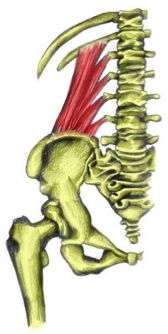Trigger Point Massage Therapy
Part 2
A Highly Effective Back Pain Treatment
Trigger point massage therapy is one the most effective types of back pain treatment for relieving myofascial trigger points.
The application of this type of back pain therapy, whether administered by oneself or a massage therapist, has the power to interrupt the referred pain signal of a trigger point.
Myofascial trigger points are areas in muscles in which the fibers have undergone a change due to chronic tightness and ischemia (low blood flow).
The
result can be referred sensation to another part of the body including
pain, tingling, numbness, thermal (hot or cold), an aching quality, or
the perception that the area "just doesn't feel right."
The difference between this type of massage therapy and other types is the specificity of application. First, the trigger point is located by palpating the suspected muscle with very gentle pressure.
A Common Example:
The Quadratus Lumborum Muscle

For example, a common trigger point location for lower back pain is the quadratus lumborum muscle.
Trigger points in the quadratus lumborum muscle have the potential to refer pain into the following referral zones…
|
• Down into the sacroiliac joint • Down into the gluteal muscles (mimicking sciatica symptoms) • Down into the hip joint |
If I suspect the presence of quadratus lumborum trigger points I will apply gentle, direct pressure to several points on this muscle (including the attachments at the transverse processes of the lumbar vertebrae as well as the belly of the muscle).
If active trigger points exist, my client will report feeling sensation in one or more referral zones.
Once I've gathered this information, I treat all active trigger points using either a static technique or a stroking technique, depending on the severity of pain.
Trigger Point Massage Therapy
Using Static Technique
For extremely tender muscles and exceptionally painful trigger points, a static technique is much preferred because it has the greatest calming affect without aggravating the tissues.
Once I locate tender points that also refer sensation, I will apply just enough pressure to elicit the trigger point referral and then I'll hold the point for 8-12 seconds. This is an ideal time frame to for interrupting the referral.
What I hope for during the 8-12 second interval is that the referred sensation will begin to diminish. The referral doesn't need to diminish completely, just to begin to diminish.
If it doesn't, it tells me that I'm using too much pressure. (Even for an experienced manual therapist, it's exceedingly easy to use too much pressure.)
I will then repeat the above process on all active trigger points returning to them with static pressure up to 4-6 times each.
You may read elsewhere... that holding a trigger point for up to 45 seconds (or just until point releases) is recommended. This is inaccurate and often leads to a false release.
There are two frequent consequences to holding trigger points for a longer than 8-12 seconds:
1. It can create a local anesthetic effect in which the muscle is momentarily numbed.
2. The muscle can just give up and create the impression that the trigger point has been interrupted.
Trigger Point Massage Therapy
Using a Stroking Technique
In cases where lower back pain exists but it isn't extreme, I will utilize a stroking method. The most calming stroking method is a repeated one-direction stroke, using moderate pressure and medium speed.
If you attempt self-massage you should feel that you're making adequate contact with the muscle but that you're not making yourself wince. It's fine if it kind of "hurts so good" but it's critical to distinguish that feeling from "it just hurts."
4-6 strokes in one direction on the muscle is often all that's needed. It's also helpful to perform 4-6 strokes in the opposite direction. If one direction feels better, feels more relieving, then that is the preferred stroking direction.

|
CURRENT COURSES POSTURAL BLUEPRINT FOR CORRECTING PELVIC TORSION: The Complete Guide To Restoring Pelvic Balance (2022) STRETCHING BLUEPRINT FOR PAIN RELIEF & BETTER FLEXIBILITY: The Complete Guide to Pain-Free Muscles Using Active Isolated Stretching (2020) HEALING THE HIDDEN ROOT OF PAIN: Self-Treatment for Iliopsoas Syndrome (2013) FREE MINI COURSE: Introduction to Active Isolated Stretching |

